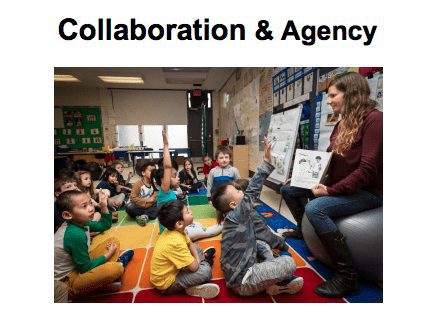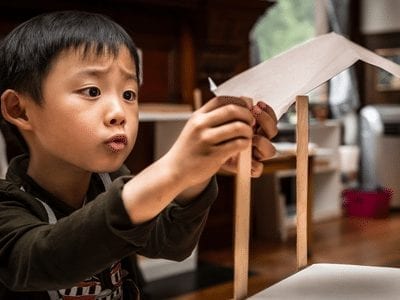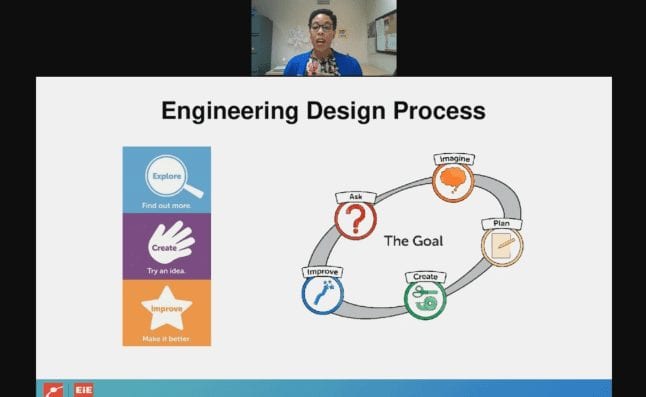Why Young Children Should Learn Engineering
Even with the NGSS’s emphasis on engineering, there’s still a feeling that in preschool and kindergarten, teachers shouldn’t place as much emphasis on the E in STEM. While four-year-olds can’t compete with even third graders in engineering, they can learn and benefit from modified lessons. Nia Keith, Director of Professional Development for EiE, Museum of Science, Boston, gave attendees insights into engineering in early education in the edWebinar, “STEM in Early Education: Empowering Problem-Solving.”
First, Keith said educators need to make sure they understand what engineering actually is. Most stop short with the idea of building something. The engineering process involves several steps, though, from asking questions to determining if what the students built solves the problem. Keith calls it a creative process, where even the youngest students engage in problem solving and asking themselves, “what if?”
Next, Keith explored how engineering curriculum design parameters, as codified by Dr. Christine Cunningham, EiE Founding Director at Museum of Science, Boston, can be adapted for early education. Keith focused on six of Cunningham’s eight parameters.

- Narrative Concept: Students should examine real world problems that are relatable to a diverse set of learners. It can be as simple as helping someone get trash out of their pond. The goal is to build the students’ empathy for someone else and give them the confidence that they can be involved in solving the problem.
- Engineering Design Process: For early education, this is three steps: Explore, Create, Improve. Students should be allowed to ask questions and create as many iterations as possible. While older students may pause and analyze success and failure in between solutions, younger children tend to move more quickly from one solution to the next. Rather than critiquing, the teacher’s role is to ask questions and have the students convey their own conclusions.
- Exploring Materials and Methods: This is a great hands-on activity for preschoolers and kindergartners. They get to touch, squish, and test the properties of different items. They can also talk about the various ways to use the materials.
- Analysis of Data for Planning and Redesign: Again, for young students, this might happen quickly or after many iterations, but it’s important for the teacher to talk to students and ask them what they think about their design. Did it solve the problem? Why or why not? Could they improve it? Here, teachers are asking students to think critically about their own work.
- Collaboration: While engineering activities in preschool might work better in stations, kindergarten students are able to work in pairs or small groups. They learn how to communicate their ideas to each other and work toward a shared goal.
- Agency: Students of all ages are more invested in the lesson when their actions directly impact the outcome. Again, this comes from the teacher allowing the students to lead the activity and make their own decisions.
Finally, what should not happen is teachers trying to move students to what they think is the “right answer.” In fact, the best engineering activities have multiple solutions and leave room for failure.
“One of the things that learners develop and explore is the sense of perseverance when designs fail,” said Keith, explaining why she thinks the improve step is the most important. “I know that traditionally in education failure is not an option…but in engineering, failure is absolutely necessary. It is part of the process. And the important thing as an educator to recognize is that our learners, our designers, our engineers never fail. Designs fail.”
This edWeb broadcast was sponsored by EiE| Museum of Science.
This article was modified and published by eSchool News.
About the Presenter
Nia Keith is the director of professional development for EiE at the Museum of Science, Boston. She attended The Ohio State University, and received a Bachelor of Arts degree in women’s studies. As a teen, Nia believed that she was “bad at science”, but with a passion for environmental advocacy, she began working as an environmental educator at the Student Conservation Association. This experience proved that she possessed an aptitude for science education. She went on to earn a Master of Science degree, with a focus on curriculum development, and to become a certified middle school science teacher in Massachusetts. Since then Nia has lead several initiatives, in both formal and informal education, including Mass Audubon’s Urban Adventures program. Her professional goal is to help every child, regardless of gender, race, or background, find a love and a connection to the sciences.
About the Host
Heather Gunsallus joined the Museum of Science in Boston during April 2018 as their executive director of sales, professional development and operations. She is passionate about building STEM programs that impact students’ and teachers’ lives, while building lifelong learners. Heather has 20 years of experience in education. She has extensive experience building and implementing both print and digital products for today’s users. Heather has managed curriculum development, professional development and sales teams, and was even a classroom teacher. Heather graduated with a Bachelor of Science in secondary education with a concentration in mathematics.
Join the Community
Engaging Early Learners is a free professional learning community onedWeb.net that provides PreK to grade three educators and administrators with a place to collaborate on teaching and nurturing the young learners under their care.
EiE is an award-winning program of the Museum of Science, Boston. Their research based curricula (preK-8) introduces all learners to the engineering design process and create the next generation of problem solvers.





Comments are closed.